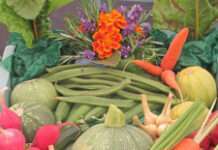Managing heat conditions is important for cattle comfort and efficiency
MANHATTAN, Kan. — Not only do hot summer days make people uncomfortable outdoors, it can also impact livestock.
K-State Research and Extension beef veterinarian A.J. Tarpoff said temperature, humidity, wind speed and solar radiation all affect cattle. Not only do producers need to watch daytime temperatures, Tarpoff said nighttime temperatures are just as important in preventing heat stress.
“They really need about six hours of nighttime cooling to dissipate the heat load they accumulated during the day,” Tarpoff said.
Two forecasting tools Tarpoff recommends are the U.S. Meat Animal Research Center’s heat stress monitor and the Kansas Mesonet.
To minimize the amount of heat stress on the cattle, Tarpoff advises producers to finish all processing or handling work with cattle before 10 a.m. on hot days, and potentially to push feeding times to later in the evening.
“When we feed cattle, they will actually increase their heat load just from digestion for the next 4 to 6 hours,” Tarpoff said.
He also recommends reducing the stocking load, which increases spacing and allows for better air circulation and easier access to water.
“During the summer months we want to increase wind speed as much as we can just to be able to dissipate some of that heat load,” he said.
Another strategy that Tarpoff recommends is providing cattle bedding and shade so that animals have a cool place to lay. “Cattle have an immense shade seeking behavior,” he said.
Tarpoff said water misters should only be used in the morning and evening for evaporative cooling of the pen surface.
“We don’t wet the cattle to cool them during the heat of the day,” he said. “That can be disastrous because we can actually increase the humidity at the pen level at that time of day.”
Tarpoff recently discussed heat stress on a recent edition of the weekday radio program, Agriculture Today. That podcast is available online.
FOR PRINT PUBLICATIONS: Links used in this story
U.S. Meat Animal Research Center, https://www.ars.usda.gov/plains-area/clay-center-ne/marc/docs/heat-stress/main
Kansas Mesonet, https://mesonet.k-state.edu
Agricultural Today podcast, https://agtodayksu.libsyn.com/956-cattle-heat-stress-managementattracting-landscape-pollinators
K State Research and Extension is a short name for the Kansas State University Agricultural Experiment Station and Cooperative Extension Service, a program designed to generate and distribute useful knowledge for the well being of Kansans. Supported by county, state, federal and private funds, the program has county extension offices, experiment fields, area extension offices and regional research centers statewide. Its headquarters is on the K State campus in Manhattan. For more information, visit www.ksre.ksu.edu. K-State Research and Extension is an equal opportunity provider and employer.
Story by:
Shelby Varner
[email protected]
More information:
A.J. Tarpoff
785-532-1255
[email protected]





